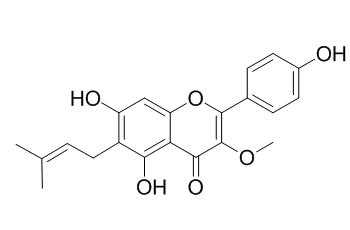Topazolin
Topazolin has weak fungitoxic activity, it displays significant activity against Salmonella typhimurium ATCC 13311 with MIC values ranging from 2 to 8 ug/mL, it also shows in vitro free radical scavenging activities with IC50 values in the range of 0.18-0.56 mg/mL.
Inquire / Order:
manager@chemfaces.com
Technical Inquiries:
service@chemfaces.com
Tel:
+86-27-84237783
Fax:
+86-27-84254680
Address:
1 Building, No. 83, CheCheng Rd., Wuhan Economic and Technological Development Zone, Wuhan, Hubei 430056, PRC
Providing storage is as stated on the product vial and the vial is kept tightly sealed, the product can be stored for up to
24 months(2-8C).
Wherever possible, you should prepare and use solutions on the same day. However, if you need to make up stock solutions in advance, we recommend that you store the solution as aliquots in tightly sealed vials at -20C. Generally, these will be useable for up to two weeks. Before use, and prior to opening the vial we recommend that you allow your product to equilibrate to room temperature for at least 1 hour.
Need more advice on solubility, usage and handling? Please email to: service@chemfaces.com
The packaging of the product may have turned upside down during transportation, resulting in the natural compounds adhering to the neck or cap of the vial. take the vial out of its packaging and gently shake to let the compounds fall to the bottom of the vial. for liquid products, centrifuge at 200-500 RPM to gather the liquid at the bottom of the vial. try to avoid loss or contamination during handling.
Wageningen University & Research2018, January 2018
Biochem Biophys Res Commun.2017, 482(4):1095-1101
Nutrients.2024, 16(20):3521.
Horticulture Research2022, uhac276.
J Ethnopharmacol.2024, 320:117426.
ACS Omega.2021, 6(36):23460-23474.
Int J Mol Sci. 2014, 15(5):8443-57
Phytother Res.2022, 10.1002:ptr.7602.
Cells.2022, 11(6):931.
Int J Mol Sci.2021, 22(9):5012.
Related and Featured Products
Fitoterapia. 2015 Jun;103:289-93.
Prenylated polyphenolic compounds from Glycyrrhiza iconica and their antimicrobial and antioxidant activities.[Pubmed:
25963162]
METHODS AND RESULTS:
A new prenylated isoflavan, iconisoflavan (1), and a new prenylated isoflav-3-ene, iconisoflaven (2) were isolated from the roots of Glycyrrhiza iconica together with four known ones namely (3S)-licoricidin (3), licorisoflavan A (4), Topazolin (5) and glycycoumarin (6). The structures were elucidated on the basis of extensive spectroscopic analysis including 1D and 2D NMR as well as HR-MS. Furthermore, the absolute configurations of compounds 1, 3 and 4 were established by electronic circular dichroism (ECD). All the isolated compounds (1-6) were evaluated for their in vitro antimicrobial activities against five pathogenic bacteria and one yeast (Candida albicans) using an in vitro microdilution method.
CONCLUSIONS:
Compounds 1 and 3-5 displayed significant activity against Salmonella typhimurium ATCC 13311 with MIC values ranging from 2 to 8 μg/mL. Additionally, all compounds were screened for their in vitro free radical scavenging activities using an in vitro microdilution DPPH assay spectrofotometrically. The tested compounds exhibited IC50 values in the range of 0.18-0.56 mg/mL, suggesting an activity comparable with that of ascorbic acid (IC50: 0.07 mg/mL). To the best of our knowledge, the present study constitutes the first phytochemical and bioactivity investigation on G. iconica.
Agricultural & Biological Chemistry, 2006, 51(4):1039-1044.
New 3-Methoxyflavones in the Roots of Yellow Lupin (Lupinus luteus L. cv. Topaz)[Reference:
WebLink]
METHODS AND RESULTS:
An isopropenyl ( = 3,3-dimethylallyl) 3-methoxyflavone (1) and its hydrate (5) were isolated from the roots of yellow lupin, Lupinus luteus L. cv. Topaz. Their structures were unambiguously determined to be 5,7,4′-trihydroxy-3-methoxy-6-(3,3-dimethylallyl)flavone (1) and 5,7,4′-trihydroxy-6-(3-hydroxy-3-methylbutyl)-3-methoxyflavone (5) by a combination of chemical and spectroscopic methods, and the new flavones were named Topazolin and Topazolin hydrate, respectively.
CONCLUSIONS:
Antifungal tests against the growth of Cladosporium herbarum indicated that, in spite of its phenolic nature and the possession of an isopentenyl sidechain, Topazolin (1) had only weak fungitoxic activity.



